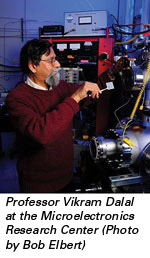 Ames, Iowa – Vikram Dalal, Thomas M. Whitney Professor of Electrical and Computer Engineering, has been elected a Fellow of the American Physical Society (APS) for his pioneering applied research in physics of thin-film photovoltaic materials and devices and for inventing industrially important photovoltaic devices. Being elected a fellow is a distinguished honor signifying recognition by one’s professional peers.
Ames, Iowa – Vikram Dalal, Thomas M. Whitney Professor of Electrical and Computer Engineering, has been elected a Fellow of the American Physical Society (APS) for his pioneering applied research in physics of thin-film photovoltaic materials and devices and for inventing industrially important photovoltaic devices. Being elected a fellow is a distinguished honor signifying recognition by one’s professional peers.
“I was delighted that my colleagues in the community chose to honor me by selecting me as an APS Fellow,” Dalal said.
Dalal has focused his career on developing thin-film photovoltaic materials and devices to enhance solar energy technologies. Thin-film solar photovoltaic cells convert sunlight into electricity. They are made from materials that absorb photons of light and release electrons. The electrons are then captured, creating an electric current that can be turned into electricity.
Dalal invented two of the basic device structures used today in thin-film silicon photovoltaic devices. His first major invention was a tandem junction solar cell based on amorphous silicon and amorphous germanium. This invention is the foundation for the thin-film silicon photovoltaic industry, which manufacturers 600 megawatts per year of thin-film silicon photovoltaic devices. His second major invention was a tandem cell comprising an amorphous and a microcrystalline silicon semiconductor, which is another structure now used throughout the thin-film silicon photovoltaic industry. Several U.S. patents have resulted from Dalal’s inventions.
Additionally, Dalal has made many pioneering advances in research on growth physics and electronic properties of amorphous and nanocrystalline silicon materials for use in photovoltaic devices. For example, he developed the electron cyclotron resonance plasma technique, which led to creating significantly better electronic properties in amorphous silicon alloys.
More recently, Dalal invented a novel device structure that uses a superlattice between an amorphous and a crystalline silicon semiconductor. This structure leads to significantly higher optical absorption in nanocrystalline silicon solar cells. When combined with other recent advances in the field, this invention likely will produce significantly higher efficiencies for future thin-film silicon-based photovoltaic devices.
He also does studies on energy systems, which includes conducting a comparative analysis of energy strategies in different countries, such as the United States, China and India.
In addition to being an APS Fellow, Dalal is a Fellow of the Institute of Electrical and Electronics Engineers (IEEE). He was the first recipient of the Micron Faculty Fellowship for Excellence at Iowa State University and is a Distinguished Visiting Faculty at the Indian Institute of Technology, Bombay. He also is currently the director of ISU’s Microelectronics Research Center and an IEEE Electron Devices Society Distinguished Lecturer. He is invited to gives talks on energy and photovoltaic science in locations worldwide, including in the United States, the Netherlands, France, Germany, United Kingdom and India.
-30-
Contacts:
Vikram Dalal, Whitney Professor of Electrical and Computer Engineering, 515 294-1077, vdalal@iastate.edu
Dana McCullough, communications specialist, 515 294-2664, schmidtd@iastate.edu